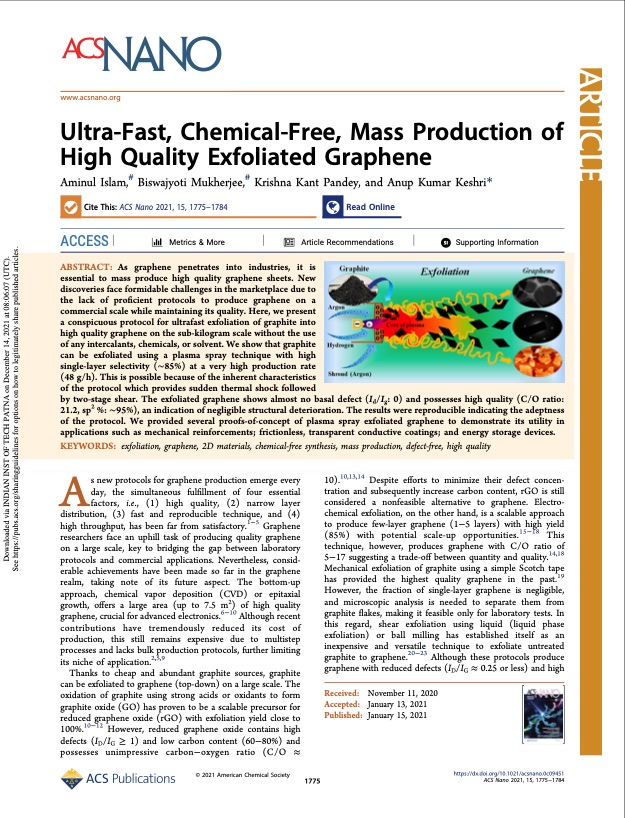
PDF Publication Title:
Text from PDF Page: 002
Article www.acsnano.org Ultra-Fast, Chemical-Free, Mass Production of High Quality Exfoliated Graphene Aminul Islam,# Biswajyoti Mukherjee,# Krishna Kant Pandey, and Anup Kumar Keshri* Cite This: ACS Nano 2021, 15, 1775−1784 Read Online ACCESS Metrics & More Article Recommendations *sı Supporting Information ABSTRACT: As graphene penetrates into industries, it is essential to mass produce high quality graphene sheets. New discoveries face formidable challenges in the marketplace due to the lack of proficient protocols to produce graphene on a commercial scale while maintaining its quality. Here, we present a conspicuous protocol for ultrafast exfoliation of graphite into high quality graphene on the sub-kilogram scale without the use of any intercalants, chemicals, or solvent. We show that graphite can be exfoliated using a plasma spray technique with high single-layer selectivity (∼85%) at a very high production rate (48 g/h). This is possible because of the inherent characteristics of the protocol which provides sudden thermal shock followed by two-stage shear. The exfoliated graphene shows almost no basal defect (Id/Ig: 0) and possesses high quality (C/O ratio: 21.2, sp2 %: ∼95%), an indication of negligible structural deterioration. The results were reproducible indicating the adeptness of the protocol. We provided several proofs-of-concept of plasma spray exfoliated graphene to demonstrate its utility in applications such as mechanical reinforcements; frictionless, transparent conductive coatings; and energy storage devices. KEYWORDS: exfoliation, graphene, 2D materials, chemical-free synthesis, mass production, defect-free, high quality As new protocols for graphene production emerge every day, the simultaneous fulfillment of four essential factors, i.e., (1) high quality, (2) narrow layer distribution, (3) fast and reproducible technique, and (4) high throughput, has been far from satisfactory.1−5 Graphene researchers face an uphill task of producing quality graphene on a large scale, key to bridging the gap between laboratory protocols and commercial applications. Nevertheless, consid- erable achievements have been made so far in the graphene realm, taking note of its future aspect. The bottom-up approach, chemical vapor deposition (CVD) or epitaxial growth, offers a large area (up to 7.5 m2) of high quality graphene, crucial for advanced electronics.6−10 Although recent contributions have tremendously reduced its cost of production, this still remains expensive due to multistep processes and lacks bulk production protocols, further limiting its niche of application.2,5,9 Thanks to cheap and abundant graphite sources, graphite can be exfoliated to graphene (top-down) on a large scale. The oxidation of graphite using strong acids or oxidants to form graphite oxide (GO) has proven to be a scalable precursor for reduced graphene oxide (rGO) with exfoliation yield close to 100%.10−12 However, reduced graphene oxide contains high defects (ID/IG ≥ 1) and low carbon content (60−80%) and possesses unimpressive carbon−oxygen ratio (C/O ≈ 10).10,13,14 Despite efforts to minimize their defect concen- tration and subsequently increase carbon content, rGO is still considered a nonfeasible alternative to graphene. Electro- chemical exfoliation, on the other hand, is a scalable approach to produce few-layer graphene (1−5 layers) with high yield (85%) with potential scale-up opportunities.15−18 This technique, however, produces graphene with C/O ratio of 5−17 suggesting a trade-off between quantity and quality.14,18 Mechanical exfoliation of graphite using a simple Scotch tape has provided the highest quality graphene in the past.19 However, the fraction of single-layer graphene is negligible, and microscopic analysis is needed to separate them from graphite flakes, making it feasible only for laboratory tests. In this regard, shear exfoliation using liquid (liquid phase exfoliation) or ball milling has established itself as an inexpensive and versatile technique to exfoliate untreated graphite to graphene.20−23 Although these protocols produce graphene with reduced defects (ID/IG ≈ 0.25 or less) and high © 2021 American Chemical Society https://dx.doi.org/10.1021/acsnano.0c09451 1775 ACS Nano 2021, 15, 1775−1784 Received: November 11, 2020 Accepted: January 13, 2021 Published: January 15, 2021 Downloaded via INDIAN INST OF TECH PATNA on December 14, 2021 at 08:06:07 (UTC). See https://pubs.acs.org/sharingguidelines for options on how to legitimately share published articles.PDF Image | Production of High Quality Exfoliated Graphene

PDF Search Title:
Production of High Quality Exfoliated GrapheneOriginal File Name Searched:
Ultra-Fast-Chemical-Exfoliated-Graphene.pdfDIY PDF Search: Google It | Yahoo | Bing
Salgenx Redox Flow Battery Technology: Power up your energy storage game with Salgenx Salt Water Battery. With its advanced technology, the flow battery provides reliable, scalable, and sustainable energy storage for utility-scale projects. Upgrade to a Salgenx flow battery today and take control of your energy future.
| CONTACT TEL: 608-238-6001 Email: greg@infinityturbine.com | RSS | AMP |